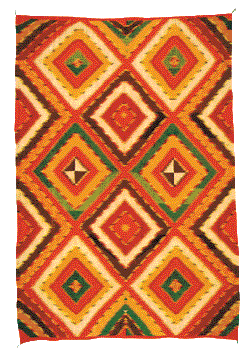The Durango Collection®
Collection Summary
| Title | Durango Collection® |
| Dates (Inclusive) | 800-current |
| Creator | Initial collection assembled by Jackson Clark I and Mark Winter; donated and endowed by Richard and Mary Lyn Ballantine. |
| Unique ID | F021 |
Historical Note
 The Durango Collection® represents 1200 years of weaving in the Southwest. The collection contains one-of-a-kind textiles woven by both male and female weavers and represent Pueblo, Navajo and Hispanic traditions. Southwest textiles are a true American art form in which diverse traditions and cultures have blended to produce new, unique expressions of beauty. The weaving tradition rooted in the American Southwest for over 1000 years began with the Ancestral Puebloans (also known as the Ancient Ones, or the Anasazi), who worked with native cotton on an upright loom. In the 1500’s, the Spanish introduced sheep and the horizontal treadle loom to the Southwest. About 300 years ago, the Navajo began to weave. While Pueblo, Navajo and Hispanic peoples who live in this region each maintain their cultural heritage, each tradition also shows its influence on the others.
The Durango Collection® represents 1200 years of weaving in the Southwest. The collection contains one-of-a-kind textiles woven by both male and female weavers and represent Pueblo, Navajo and Hispanic traditions. Southwest textiles are a true American art form in which diverse traditions and cultures have blended to produce new, unique expressions of beauty. The weaving tradition rooted in the American Southwest for over 1000 years began with the Ancestral Puebloans (also known as the Ancient Ones, or the Anasazi), who worked with native cotton on an upright loom. In the 1500’s, the Spanish introduced sheep and the horizontal treadle loom to the Southwest. About 300 years ago, the Navajo began to weave. While Pueblo, Navajo and Hispanic peoples who live in this region each maintain their cultural heritage, each tradition also shows its influence on the others.
In the Pueblo tradition, weaving was originally the work of men; in the Navajo tradition, weaving is often passed from grandmother to mother to daughter; Hispanic weaving often takes place within a family workshop. However, in today’s mobile culture, these patterns are becoming blurred as weaving and weaving technology is taught in school-sponsored programs, craft cooperatives and over the Internet.
Southwest weaving today blends traditional techniques with indigenous cotton, wool introduced by the Spanish, contemporary materials and shared designs. People’s ability to adapt assures that the Southwest textile tradition remains an active and vital art form. The beauty, creativity and skill shown by the textiles in the Durango Collection® chronicles this remarkable achievement.
Restrictions
Access. An appointment must be made with the Curator, Jeanne Brako, to access the collection for research purposes. The collection is regularly exhibited in the gallery at the Center of Southwest Studies and other institutions around the country. If your institution is interested in borrowing pieces for a formal exhibit, do not hesitate to contact us.
Use and Copyright. Duplication
of images of the Durango Collection® must be arranged with the Center according to the Image Duplication Request Form. The user assumes full
responsibility for observing all applicable laws regarding copyright, property
rights, and libel.
Preferred Citation
Durango Collection®, Fort Lewis College. Center of Southwest
Studies.
Acquisition Info
The Durango Collection® weavings were originally purchased by Jackson Clark I, who established Toh-Atin Gallery, and Mark Winter, who now owns the Toadlena Trading Post.
This is a "living collection" because it was endowed by Richard and Mary Lyn Ballantine who have given the Center the financial flexibility to add to the collection. Thanks to the Ballantines’ financial support we can bring to the Center of Southwest Studies guest speakers and experts on weaving, and we can travel the collection. The Durango Collection® is also a living collection in the sense that we seek to communicate the lives and cultures of the weavers, and to place these rugs, mantas, and shawls into the culture and historic fabric of the Greater Southwest.
Thanks to Mark and Lerin Winter and Richard and Mary Lyn Ballantine, the Durango Collection® has remained in the Southwest. The collection was recieved as a gift to Fort Lewis College through the Fort Lewis College Founation. The Durango Collection® continues to attract visitors to our community and to the Fort Lewis campus.
Related Materials
| F014 | Other Southwest textiles |
Access Terms
Indian textile fabrics--Southwest, New.
Navajo textile fabrics--Southwest, New.
Pueblo textile fabrics--Southwest, New.
Textile fabrics, Ancient--Southwest, Old.
Weaving--Hispanic Americans.
